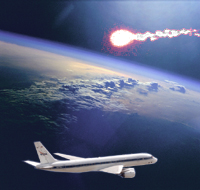Patrick Wiggins, our on-site ambassador, reports from Wendover: "I had to drive through wind, then rain and then snow before finally breaking out of the weather about 60 km west of my house. The rest of the ~150 km journey to Wendover UT/NV (it straddles the border) was under increasingly clear skies. Several people were already at the Wendover airport when I arrived about 1 hour before Stardust was scheduled to arrive. There was a very opaque cloud bank to the west that was moving slowly our way and by the time Stardust neared, the clouds were up to about 25 degrees in the western sky. At about 2:58 an incredibly bright light exploded from behind the approaching cloud bank trailing a pencil thin purplish/pinkish ion train. It was beautiful! And the crowd erupted. It passed high in the southern sky and was noticeably dimming as the spacecraft slowed and moved to where we were seeing it from the rear. It then disappeared into the a line of clouds high in the SE and we did not see it come out the other side. About 2.5 minutes later, as we all stood trying to be quiet, a surprisingly loud sonic boom was heard (actually it sounded like two booms very close together) and the crowd erupted into 2 chants of "Welcome Home Stardust"."
Jim Albers reports from Redding, CA: "Bryan and I saw it. He picked it up East of Polaris. He got a number of stills, a few of which have been posted. I'll have to take some time to go through my video to see if I got anything. We received a number of visual reports, some of which were also posted on a separate page."
Allan Meyer of the SOFIA program at NASA Ames reports from Redding, CA: " Had a nice view from a hill (800') about 10 miles NE of Redding, clear and cold. First spotted SRC right about 9:57 where expected below Ursa Major. Similar brightness and color to Alpha Ori ( about vis. mag. +0.5). Brightness, color seemed quite constant, no trail or wake visible. Must have been intrinsically getting brighter, as it seemed at least at bright at very low elevation ( a few degrees). My wife's uncle (89 years old) came out and saw it as well. Caught a few seconds of it on hand-guided analog video, preceded by some tape of Alpha Boo. Will copy to digital 8, send along with GPS pstn. Congratulations on a successful flight!"
Dr. Hajime Yano, one of the leading researchers of the Hayabusa (MUSES-C) mission, send the following congratulations: I just want to congratulate you and all your crew the successful airborne observation of the Stardust SRC. I clearly remember the night we returned to Edwards from the final flight of the 2002 Leonid MAC mission. We had a late snack at Denny's and you asked me what we should do for airborne missions in the post-Leonid era. As a MUSES-C scientist, I quickly replied you to go for interplanetary capsule reentry observation as an artificial, known meteor. Then my salute goes to your perseverance and all the efforts to make it come true. I am sure that your campaign will produce a wealth of new data in meteor science as well as capsule engineering. All my best wishes to our old Leonid MAC teammates on board at this time. Now it is my turn to check samples in aerogels at Houston; I will fly there this afternoon."
John Sanford at Fresno reports: " Sorry poor weather prospects precluded my participation, and it was 80% cloudy/misty here at reentry time, so I ended up watching the recovery on TV."









